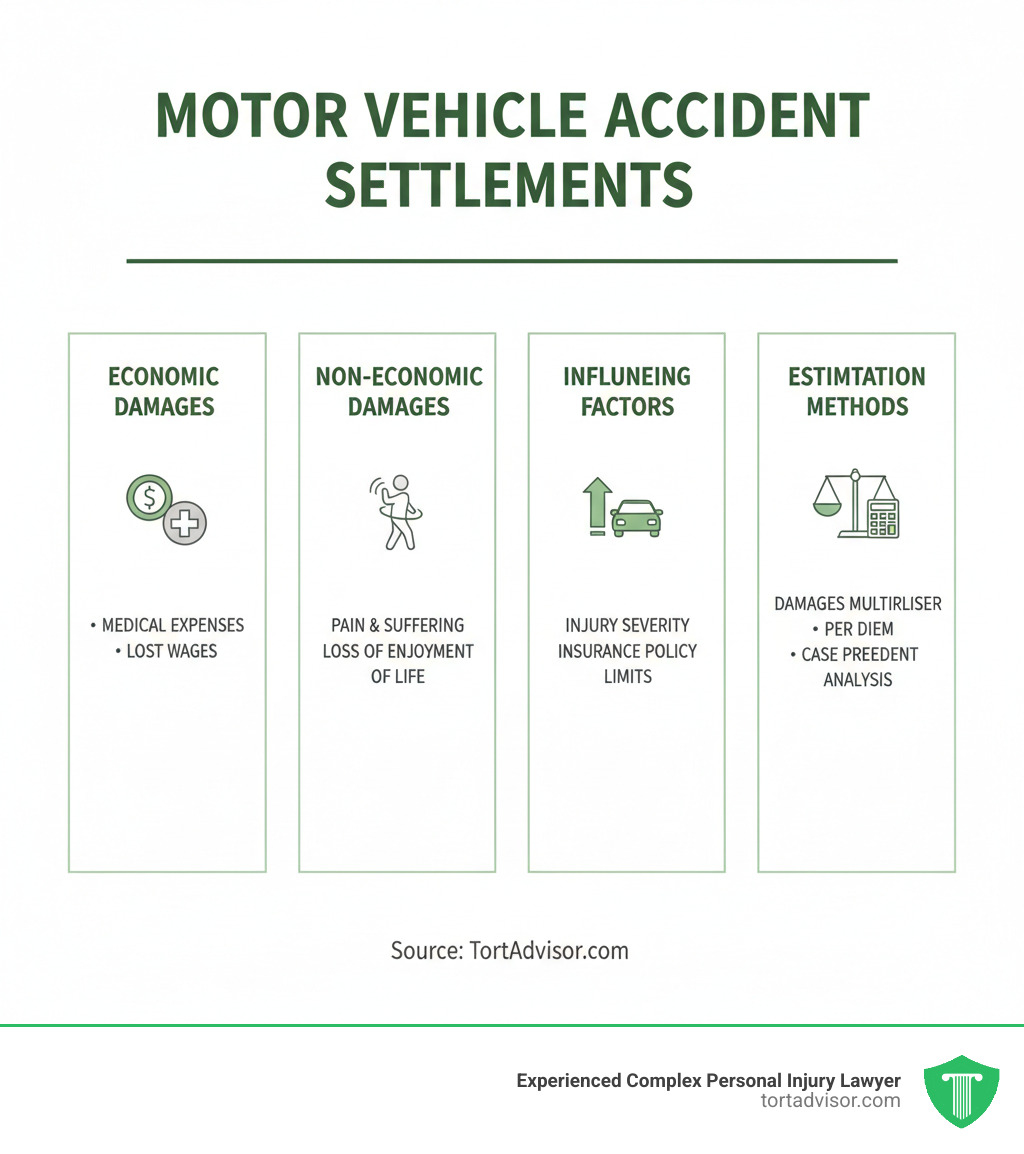


Why Understanding Motor Vehicle Accident Settlement Amounts Matters After a Crash
Motor vehicle accident settlement amounts can range from a few thousand dollars for minor injuries to over $1 million for catastrophic cases—but most people have no idea where their claim falls on that spectrum. If you’ve been injured in a car accident, you’re likely facing medical bills, lost wages, and mounting stress while trying to figure out what your case is actually worth.
Quick Answer: Typical Settlement Ranges by Injury Severity
- Minor injuries (soft tissue, whiplash): $10,000–$50,000
- Moderate injuries (fractures, herniated discs): $50,000–$250,000
- Severe/catastrophic injuries (TBI, spinal cord damage, paralysis): $250,000–$1,000,000+
- No injury (property damage only): Typically $0–$5,000
These ranges vary widely based on factors like medical expenses, lost income, pain and suffering, and insurance policy limits. The actual settlement depends on your specific circumstances—not averages.
After a car accident, insurance companies often make lowball offers that don’t reflect the true value of your claim. This guide breaks down three proven methods to estimate your settlement amount, explains the key factors that influence final payouts, and shows you how to steer the claims process. You’ll learn how to calculate damages and avoid common pitfalls that leave money on the table.
About the Author: I’m Mason Arnao, and while my primary expertise is in technology and SaaS architecture, I’ve spent considerable time researching motor vehicle accident settlements. My background in data analysis has given me a unique perspective on evaluating the factors that drive fair compensation.
Essential motor vehicle accident settlement amounts terms:
- common motor vehicle accident injuries
- how to report a motor vehicle accident
- motor vehicle accident attorney near me
Understanding the Building Blocks of a Settlement
A personal injury settlement is an out-of-court agreement between you and the at-fault party’s insurance company. This deal provides you with money to cover your losses in exchange for closing the case. It offers a faster resolution and more control over the outcome than a trial.
At the heart of every settlement are compensatory damages, which are designed to restore what you lost. The goal is to put you back in the financial position you were in before the accident. These damages fall into two categories: economic damages (tangible, calculable losses) and non-economic damages (intangible impacts like pain and suffering). Both are critical in determining fair motor vehicle accident settlement amounts.
The injuries you sustain make all the difference. Common Motor Vehicle Accident Injuries range from whiplash to life-altering spinal cord damage, and each brings its own set of compensable losses.
What Damages Are Covered in a Settlement?
A comprehensive settlement accounts for every way the crash has affected your life, both now and in the future.
- Medical Expenses: This includes everything from the initial emergency room visit to ongoing physical therapy, prescription medications, and rehabilitation. Crucially, it also covers projected future medical care, such as surgeries or long-term pain management.
- Lost Wages and Earning Capacity: You can recover the salary, hourly pay, and bonuses you missed while unable to work. If your injuries permanently affect your ability to earn money, you can claim loss of earning capacity, which projects your reduced earnings over your career.
- Property Damage: This covers the cost to repair or replace your vehicle and any personal items damaged in the crash, like a laptop or phone.
- Pain and Suffering: This compensates you for the physical pain and emotional distress your injuries caused. Because there’s no receipt for suffering, this is often the most contentious part of a settlement. Some jurisdictions may cap these damages or require an injury to be “serious and permanent” to qualify.
- Loss of Enjoyment of Life: This recognizes that injuries can prevent you from participating in hobbies, sports, and other activities you once loved. These losses have value and deserve compensation.
- Other Expenses: Don’t forget out-of-pocket costs like travel to medical appointments, hiring help for housekeeping or yard work, and modifications to your home or vehicle.
Every loss you’ve endured factors into calculating a fair settlement.
3 Proven Methods to Estimate Your Motor Vehicle Accident Settlement Amount
Figuring out what your motor vehicle accident settlement amounts might be isn’t an exact science. There’s no perfect formula, but you’re not flying blind. We can use proven methods to get a reasonable ballpark figure, though the final amount will depend on your unique circumstances.
Online calculators can offer a starting point, but they often miss the nuances of an individual case. A better approach is to combine structured calculation methods with real-world data. If you want a personalized estimate, check out our MVA Settlement Calculator. Understanding how these calculations work will empower you during the claims process.
Method 1: The Damages Multiplier Method
The multiplier method is a widely used approach for estimating settlement value. First, you add up all your economic damages—medical bills (past and future), lost wages, and other out-of-pocket expenses. Let’s say these total $15,000.
Next, you multiply that total by a number between 1.5 and 5 (or higher for catastrophic injuries) to account for non-economic damages like pain and suffering. The multiplier depends on the severity of your injuries:
- Minor injuries (heal quickly): Multiplier of 1.5 to 2.
- Moderate injuries (fractured arm, herniated disc): Multiplier of 3 to 4.
- Severe/catastrophic injuries (TBI, paralysis): Multiplier of 5 or higher.
For example, with moderate injuries and $15,000 in economic damages, a multiplier of 3 would be reasonable. The calculation would be $15,000 (economic) × 3 (multiplier) = $45,000 (non-economic). Add that to the original $15,000, and the total estimated settlement is $60,000.
Method 2: The Per Diem Method
The per diem (Latin for “per day”) method calculates pain and suffering based on a daily rate. This approach works best for injuries with a clear recovery timeline.
First, establish a daily rate, often based on your daily earnings. The logic is that a day spent in pain is worth at least as much as a day you could have been working. If you earn $200 per day, that can be your rate.
Next, multiply that rate by the number of days you experienced significant pain, from the accident date until you reach Maximum Medical Improvement (MMI). If you suffered for 90 days at a $200/day rate, your non-economic damages would be $18,000 (90 x $200). Add your $15,000 in economic damages for a total estimated settlement of $33,000.
This method is less suitable for permanent injuries, as the numbers can become unreasonably large over a lifetime.
Method 3: Analyzing Average Motor Vehicle Accident Settlement Amounts
While every case is unique, looking at average settlements for similar injuries provides valuable context. However, use these figures as a general guide, not a guarantee.
- Minor injuries (whiplash, sprains): Settlements typically range from $10,000 to $50,000. Averages vary widely by state; for example, minor injury payouts might average under $10,000 in one state but over $20,000 in another.
- Moderate injuries (fractures, herniated discs): The typical range is $50,000 to $250,000. State averages for these types of injuries often fall between $35,000 and $60,000.
- Serious or catastrophic injuries (TBI, spinal cord damage): Settlements jump dramatically to $250,000 to over $1,000,000. Averages for severe injuries can range from $200,000 to over $1 million, depending on the state and the specifics of the case.
These numbers show a clear trend: the more severe and long-lasting your injuries, the more your case is worth. Your actual settlement will depend on the strength of your evidence and legal representation. A knowledgeable Car Accident Compensation Attorney can steer these complexities to position your case for maximum compensation.
Key Factors That Will Adjust Your Final Settlement
The estimation methods are just a starting point. The actual motor vehicle accident settlement amounts you receive can swing dramatically based on several crucial factors. This is where having a skilled attorney can make all the difference.
Think of your settlement like a recipe—the final outcome depends on how all the ingredients come together. State laws, insurance policies, and the quality of your evidence all play a major role. If you’re wondering if you need professional help, this guide on Do I Need a Personal Injury Lawyer can help clarify when to hire representation.
The Impact of Fault and State Laws
Who caused the accident is critical, but how your state assigns fault can completely change your settlement. Most states are at-fault (tort) states, where the responsible party pays for damages. A minority are no-fault states, where your own insurance covers initial medical bills regardless of fault.
Even if the other driver was mostly to blame, your own actions can reduce or eliminate your payout depending on your state’s negligence laws:
- Contributory Negligence: In a few states, if you are found even 1% at fault, you cannot recover any damages.
- Pure Comparative Negligence: Your settlement is reduced by your percentage of fault. If you are 70% at fault for a $100,000 claim, you can still receive $30,000.
- Modified Comparative Negligence: This is the most common system. You can recover damages as long as your fault is below a certain threshold (usually 50% or 51%). If you are 25% at fault for a $100,000 claim, you get $75,000. But if you are found 51% at fault, you get nothing. Indiana, for example, follows this 51% rule as detailed in Indiana’s comparative fault law.
Insurance Policy Limits, Deductibles, and Legal Caps
An uncomfortable truth is that a settlement is limited by the available insurance coverage. If the at-fault driver only has a $25,000 bodily injury policy limit, that’s likely the most their insurer will pay, even if your claim is worth $500,000.
This is why uninsured/underinsured motorist (UIM) coverage on your own policy is so important. It can cover the gap when the at-fault driver has too little or no insurance.
Other financial limitations can include:
- Statutory Deductibles: Some jurisdictions automatically subtract a fixed amount from certain damages, like pain and suffering awards.
- Pain and Suffering Caps: Many states place a legal limit on the amount of non-economic damages you can receive, regardless of your injury’s severity.
The Strength of Your Evidence and Documentation
Insurance companies require proof. The quality of your evidence can make or break your claim. Strong documentation pressures insurers to make fair offers.
Key evidence includes:
- Medical Records: Diagnostic tests (X-rays, MRIs), treatment plans, and prognoses from specialists provide objective proof of your injuries and future needs.
- Police Report: This provides an official account of the accident, often including an initial assessment of fault.
- Photos and Videos: Images of vehicle damage, the accident scene, and your injuries create a powerful visual record.
- Witness Statements: Independent witnesses can corroborate your version of events.
- Proof of Lost Income: Pay stubs, tax returns, and letters from your employer document your financial losses.
- Expert Testimony: For complex cases, accident reconstructionists, medical specialists, and vocational experts can provide invaluable analysis.
For guidance on what to do immediately after a crash, see How to Report a Motor Vehicle Accident.
Navigating the Settlement Process from Claim to Payout
The path from injury to settlement can feel like a maze. Understanding the stages helps you stay patient and make smart choices. Most car accident cases settle out of court, which is good news. Trials are expensive, time-consuming, and unpredictable. But when negotiations fail, filing a lawsuit becomes necessary. You can learn more about what that involves in this guide to Personal Injury Lawsuits.
No-Fault vs. Tort Claims
In the U.S., your path to compensation depends on whether you live in a “no-fault” or “at-fault” state. This distinction is critical.
In no-fault states, you first turn to your own insurance policy for Personal Injury Protection (PIP) benefits, regardless of who caused the crash. PIP covers immediate expenses like medical bills and lost wages up to a certain limit. The advantage is quick access to funds without having to prove fault. However, to sue the at-fault driver for pain and suffering and other damages beyond your PIP coverage, your injuries must meet a certain threshold, which can be defined as a “serious injury” or a specific monetary amount in medical costs.
In at-fault states (also called tort states), the process is more direct: you file a claim against the at-fault driver’s insurance company from the start. You must prove the other driver was negligent to recover any damages. While you don’t have to meet a threshold to claim pain and suffering, you must wait for the liability investigation to conclude before receiving compensation.
A skilled lawyer knows how to coordinate these claims to maximize your total recovery. For a detailed walkthrough, the Understanding the claims process resource from the Financial Services Regulatory Authority offers a useful overview of general principles.
The Role of a Personal Injury Lawyer in Maximizing Your Claim
Is hiring a lawyer worth it? Statistics show that claimants with experienced personal injury lawyers often receive significantly higher settlements than those who go it alone. Insurance companies have teams of adjusters and lawyers focused on minimizing payouts. A skilled lawyer levels the playing field.
Your lawyer will:
- Calculate the true, long-term value of your claim.
- Gather all necessary evidence, including expert opinions.
- Handle all communication with insurance companies.
- Steer complex legal deadlines and procedures.
- Negotiate aggressively for a fair settlement.
- Take your case to trial if a fair offer is not made.
A lawyer allows you to focus on healing while they handle the legal battle. For a deeper look, read What Can a Personal Injury Lawyer Do For You.
Typical Timelines and the Statute of Limitations
“How long will this take?” is a common question with no simple answer. A claim generally cannot be settled until you reach Maximum Medical Improvement (MMI)—the point where your condition has stabilized. Settling before MMI is risky, as you may not know the full extent of your future medical needs.
Reaching MMI can take months for minor injuries or over a year for serious ones. After that, negotiations with the insurer can take several more months. If a lawsuit is filed, court backlogs can add a year or more to the timeline.
The most critical deadline is the statute of limitations: the legal time limit for filing a lawsuit. In most states, you have two years from the date of the accident. If you miss this deadline, you lose your right to sue forever. It’s crucial to consult a lawyer as soon as possible to protect your rights.
Frequently Asked Questions about Motor Vehicle Accident Settlements
After a car accident, questions about motor vehicle accident settlement amounts are common. Here are straightforward answers to the ones we hear most often.
Are car accident settlement amounts taxable in the US?
Here’s some good news: in most cases, the core components of your settlement for physical injuries are not taxable. The IRS does not consider compensation for pain and suffering, medical expenses, or emotional distress related to a physical injury to be income. It’s money intended to make you whole again.
However, there are important exceptions. Any portion of your settlement that replaces lost wages or income is generally taxable. The logic is that you would have paid taxes on that income if you had earned it normally. Punitive damages, which are rare and designed to punish the defendant, are also considered taxable income.
Tax implications can be complex. We strongly recommend consulting a qualified tax professional to review your settlement agreement and avoid any surprises.
Do most car accident cases settle out of court?
Yes. Over 95% of personal injury cases, including car accidents, are resolved through a settlement without going to trial. There are several practical reasons for this:
- Cost: Trials are expensive, with fees for experts, court filings, and legal services that can reduce your net recovery.
- Time: A trial can add years to the process due to court backlogs and appeals.
- Risk: A jury’s decision is unpredictable. You could win big or walk away with nothing.
- Control: A settlement is a negotiated agreement. You have the final say and know exactly what you are getting.
When direct negotiations stall, mediation (using a neutral third party to facilitate an agreement) or arbitration (where a neutral party makes a binding decision) can help resolve the case without a full trial.
What is a fair settlement for pain and suffering?
This is one of the most subjective and challenging parts of calculating a settlement. There is no fixed formula for pain and suffering because your experience is personal.
The value is determined by several factors:
- The severity and permanency of your injuries.
- The length of your recovery time.
- The impact on your daily life (work, hobbies, relationships).
- The extent of emotional and psychological distress, such as anxiety or PTSD.
Lawyers use the multiplier and per diem methods as starting points, but the final value is determined through skilled negotiation. An experienced attorney knows how to build a compelling narrative around your suffering, referencing similar case outcomes to justify a higher amount and pushing back against insurers’ attempts to downplay your experience. This is where skilled legal representation can make a dramatic difference in your final settlement.
Conclusion
Estimating motor vehicle accident settlement amounts is more of an art than a science. We’ve walked through the essential components: understanding your damages, using estimation methods like the multiplier and per diem approaches, and recognizing the factors that can adjust your final payout.
While these tools provide a helpful starting point, your case is unique. The specifics of your injuries, the impact on your life, the available insurance coverage, and state laws all matter tremendously. Navigating this complex process while also dealing with physical and emotional recovery is a monumental task.
You shouldn’t have to become a legal expert to get fair compensation. This is why the right legal representation is so critical. A skilled personal injury lawyer understands the tactics insurance companies use to minimize payouts and knows how to build a case that reflects your true losses.
At Tort Advisor, our mission is to connect injured people with highly skilled attorneys who have proven track records in car accident cases. We vet our network to ensure you’re working with a professional who delivers results.
If you’re wondering what fair compensation looks like for your situation, don’t go it alone. The insurance companies have a team of experts on their side; you deserve one on yours.
Find an experienced attorney for your car accident lawsuit
Your recovery and your future matter. Let us help you take the next step toward securing the compensation you deserve.
Free Confidential Case Evaluation
Complete the short form below to get an immediate FREE case review with an expert in your specific claim. Don't wait, your case could be time sensitive to file a claim.
Related Posts
Did a North Dakota product cause harm? Understand product liability, your rights, and how to take action for defects.
Get justice for clergy abuse. Find an expert Priest abuse lawyer to navigate complex laws and hold institutions accountable.
Diagnosed with meningioma after Depo-Provera? Understand potential Depo-Provera lawsuit settlements, risks, & how to claim compensation.
Uncover the truth about uber sexual assault cases. Learn about the alarming scale, Uber's accountability, and legal options for justice.
Facing wildfire losses? Discover the best wildfire lawsuit attorneys in California to fight for your full recovery and justice.
Exposed to Roundup & diagnosed with NHL? Discover how to sue Monsanto, understand eligibility, & seek compensation. Your guide to justice.










